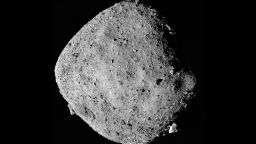Scientists have identified the presence of tryptophan, an essential amino acid, in samples collected from the asteroid Bennu. This significant discovery comes from NASA’s OSIRIS-REx mission, which successfully returned a cache of material from Bennu to Earth in 2023. The findings enhance our understanding of the building blocks of life and suggest that these components may have originated beyond our planet.
The Significance of Tryptophan on Bennu
Tryptophan is often associated with the myth that consuming turkey induces sleepiness during Thanksgiving, but its significance extends far beyond culinary lore. The analysis of the Bennu samples indicates that tryptophan, previously undetected in any meteorite or space sample, is the 15th amino acid identified on the asteroid out of the 20 known to support life on Earth.
José Aponte, an astrochemist at NASA’s Goddard Space Flight Center and coauthor of the study published in the journal PNAS, emphasized the breakthrough nature of this finding. “Finding tryptophan in the Bennu asteroid is a big deal,” he stated. “Seeing it form naturally in space tells us that these ingredients were already being made out in the early solar system.” This discovery strengthens the theory that asteroids like Bennu may have played a crucial role in delivering essential life ingredients to Earth.
The samples were collected during the OSIRIS-REx mission, which landed on Bennu in 2020. NASA retrieved approximately 4.3 ounces (121.6 grams) of rocks and dust from the asteroid. Since then, portions of this material have been distributed to researchers worldwide for further analysis.
Bennu: A Window into the Early Solar System
Bennu, named after an ancient Egyptian deity associated with creation and rebirth, is approximately one-third of a mile wide. It is believed to be a fragment of a larger asteroid that separated between 2 billion and 700 million years ago. Its chemical composition offers insights into the early solar system, dating back about 4.5 billion years.
The asteroid has been in orbit close to Earth for approximately 1.75 million years. Current estimates suggest that Bennu could collide with Earth in the year 2182, with a calculated impact probability of 1 in 2,700 (or 0.037%). This potential impact could lead to significant climate changes, including a “global winter.”
Materials in Bennu originated from supernova explosions that occurred before the solar system formed. These explosive events generated the elements that make up the asteroid, which underwent further alteration from heat and radiation during its formation. In addition to tryptophan, Bennu contains ammonia and various minerals, contributing essential ingredients for the synthesis of life’s building blocks.
Angel Mojarro, a postdoctoral researcher and organic geochemist at NASA’s Goddard Space Flight Center, noted that the discovery of tryptophan expands the known diversity of amino acids produced in space. “What this is telling us is that many of the building blocks of life can be produced naturally within asteroids or comets,” he said. “Finding tryptophan expands the alphabet of amino acids that could have been delivered to Earth.”
While a total of 33 amino acids have previously been identified on Bennu, only 14 are used by living organisms to form proteins. Tryptophan is categorized as an essential amino acid, meaning it cannot be synthesized by the human body and must be obtained through diet.
Despite the promising findings, further testing is necessary to confirm the presence of tryptophan in the analyzed sample, which weighed just 50 milligrams. Nevertheless, the pristine condition of the Bennu samples makes it unlikely that terrestrial contamination influenced the results, according to George Cody, a staff scientist at the Carnegie Institution for Science. “I believe these molecules are legitimately derived from the Bennu asteroid,” Cody stated.
The OSIRIS-REx mission’s ability to collect samples directly from Bennu without atmospheric interference allows researchers to study the asteroid’s original chemistry. Dante Lauretta, a professor of planetary science at the University of Arizona and coauthor of the study, remarked on the significance of the pristine samples. “Because OSIRIS-REx returned these samples pristine, we’re finally seeing the fragile salts, minerals, and organics that meteorites lose on entry,” he said.
Implications for the Origins of Life
The findings regarding tryptophan and other amino acids in extraterrestrial materials enhance our understanding of the molecular foundations necessary for life. According to Cody, if the natural chemistry of the early solar system produced the same molecules utilized by living organisms today, it suggests a deeper connection between these processes. The late Harold Morowitz, a pioneer in studies of life’s origins, theorized that the core molecules of living organisms may be “molecular fossils” from the solar system’s beginnings.
Kate Freeman, a professor at Penn State University, emphasized the broader implications of this research. “Asteroids were the early Earth’s grocery delivery service, having provided a wealth of molecules to our prebiotic world,” she stated. The study also underscores the importance of sample return missions, according to Sara Russell, a professor of planetary sciences at the Natural History Museum in London. “Although scientists have thousands of rocks from space available in labs in the form of meteorites, they also need uncontaminated, pristine material brought to Earth by space missions,” she explained.
The discovery of tryptophan in Bennu is a remarkable addition to the growing evidence that essential ingredients for life may have been delivered to Earth by asteroids, reshaping our understanding of life’s origins in the universe.







